Previously on Drokk!: We’ve made it nine years into the comic book career of Judge Dredd, and we’ve watched the character come into his own after a number of missteps, with the eventual return of co-creator John Wagner midway through his second year being the turning point. With that in mind, the prospect of tackling a collection of one-off stories from throughout that same period, originally published in annuals and special issues, sure sounds like fun, right…?
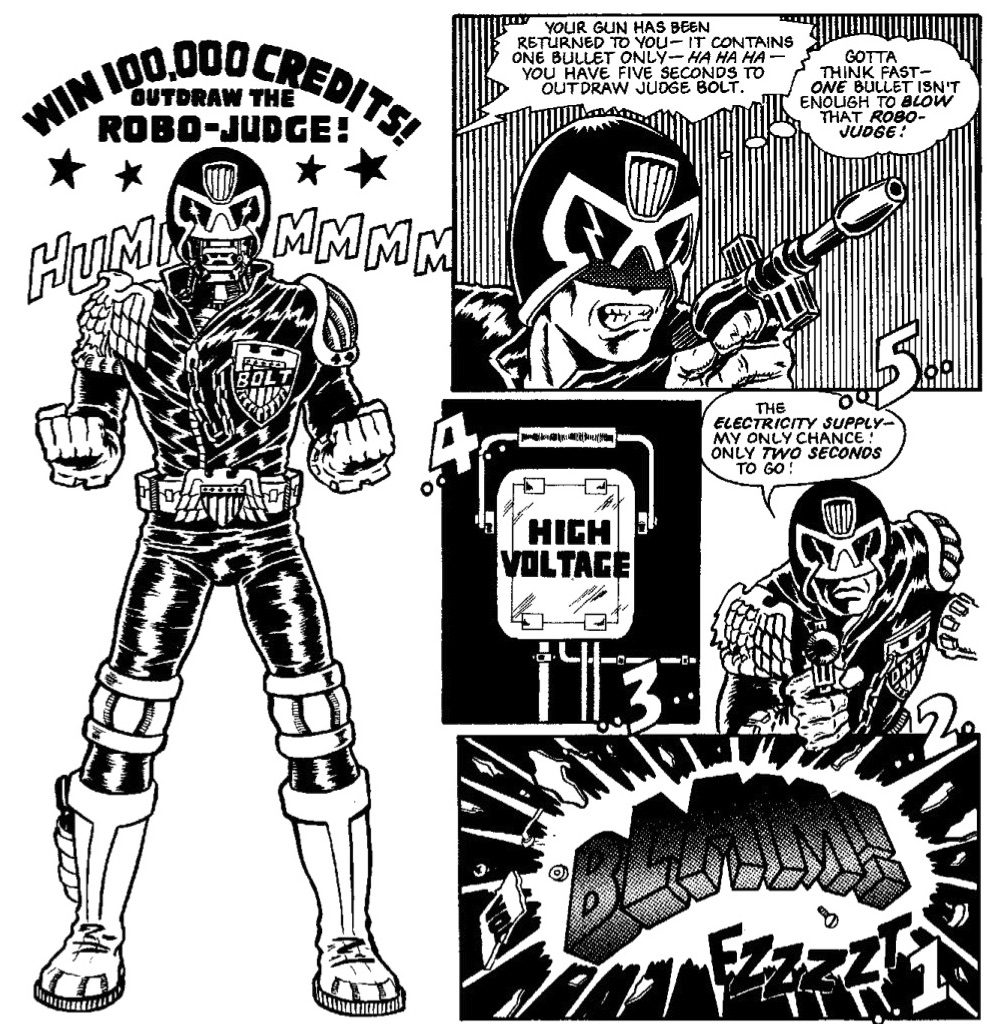
0:00:00-0:03:34: In which we briefly introduce ourselves, the intro gets away from me — note that I’m literally in the middle of a sentence when throwing it to Jeff to introduce himself, and he just runs with it — and we briefly touch upon the fact that both a dog’s breakfast and a dog’s bollocks are somehow noteworthy, but not as the layman might expect. More importantly, we talk about the fact that neither of us really liked the volume we’re talking about this episode, Judge Dredd: The Restricted Files Vol. 1. It’s… not good.
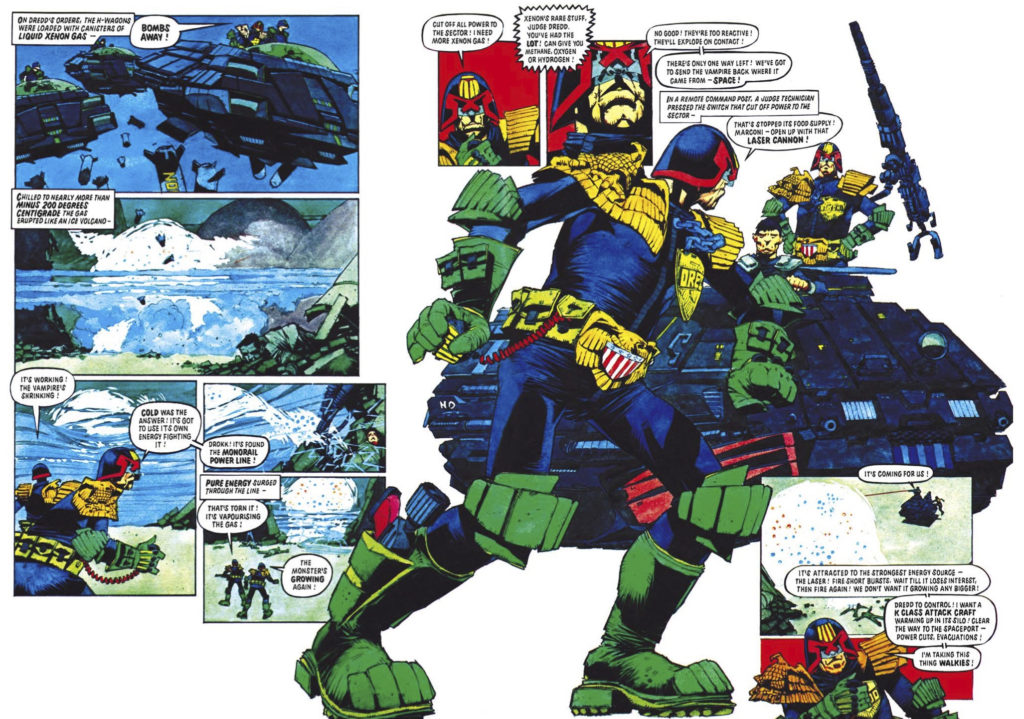
0:03:35-0:11:04: Stumbling into a discussion about the book, we talk about the unevenness of the book, especially as it relates to the (high) quality of the artwork versus the not-so-high quality of the writing. Are stories intended for annuals and specials by their very nature underwhelming, even if they’re written to be (as Jeff puts it), “visually big”? We also talk about how long it takes to get to the good stories, and our different ideas of what that actually means. (Spoilers: Jeff is far more forgiving of early Alan Grant than I am.)
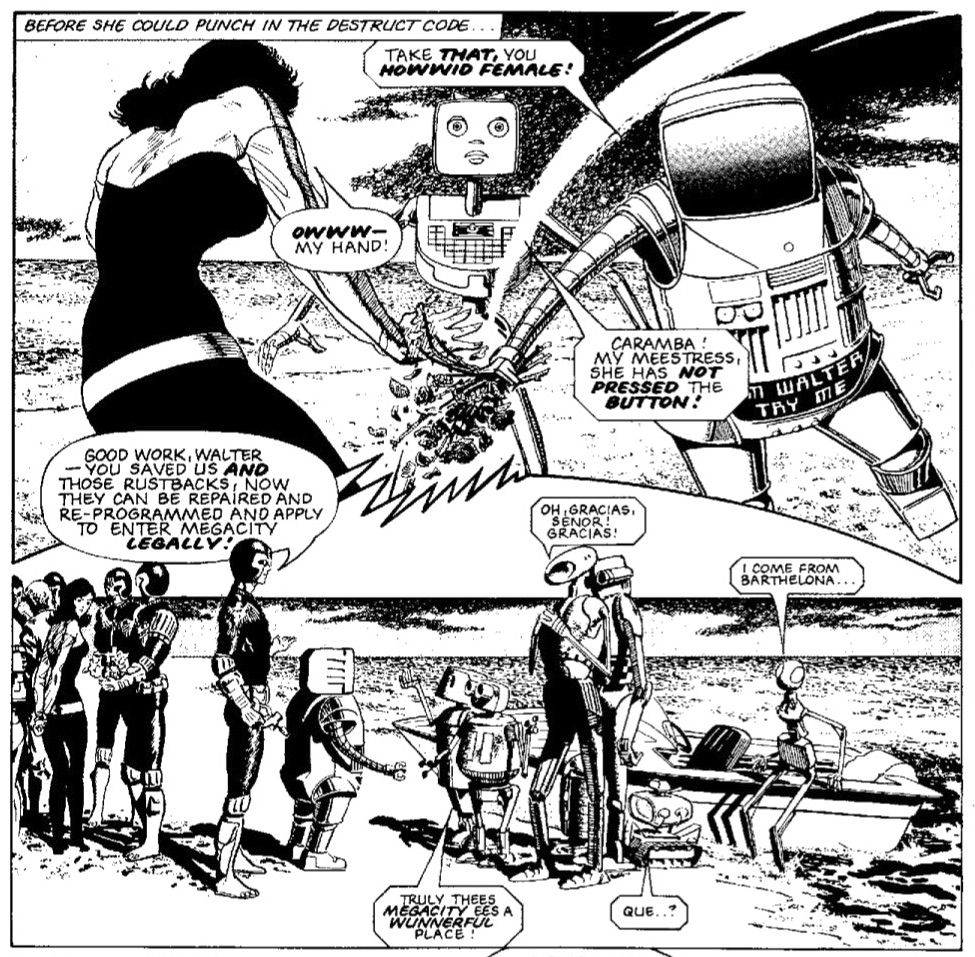
0:11:05-0:17:37: Perhaps a little later than would be useful, I give a little bit more context about 2000 AD annuals in general, and their prospective audience and purpose, before we talk about the appalling casual racism on show in one of the stories — really, it’s astonishing — and whether or not “Pinboing Wizard” is the first actually enjoyable story in the volume — “only” twelve stories into the book itself.
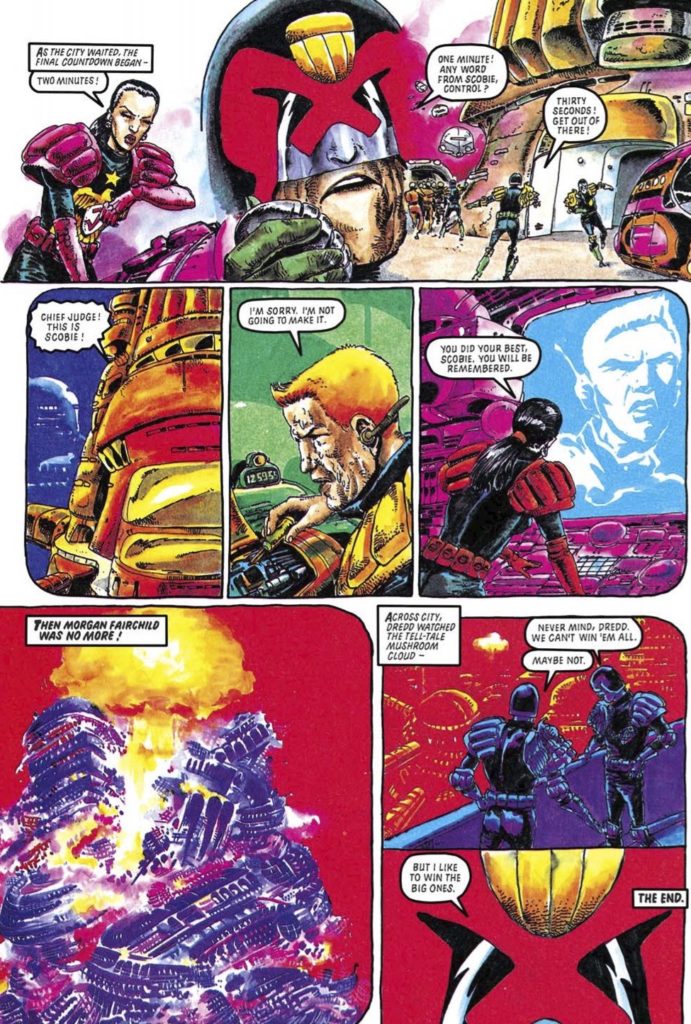
0:17:38-0:30:47: If annuals and specials were intended to act as introductions to the characters, then surely a collection of those stories would be a great introductory volume for a new reader, right…? Well, not exactly, and we start to break down quite why that might be the case. Is there a lack of nuance in these stories, or simply a lack of darkness? It’s surely no coincidence that the stories Jeff and I enjoy most in the volume are the more downbeat ones, and the moments in the comedy stories are the more… grim jokes…
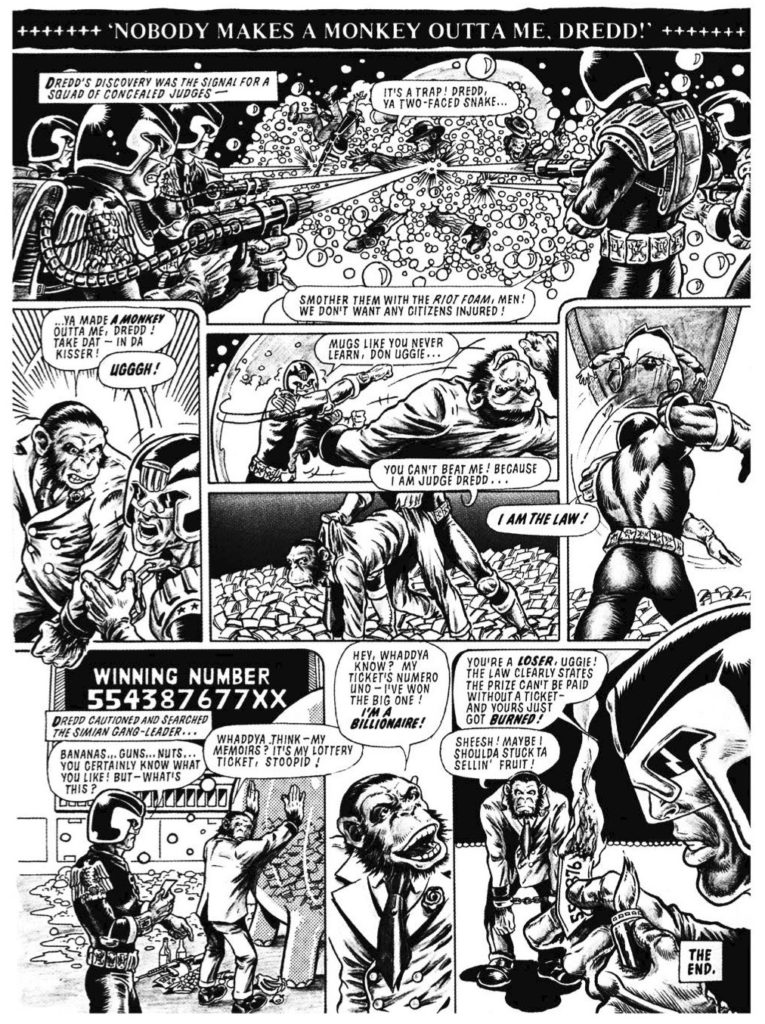
0:30:48-0:42:25: We take a brief diversion from the meat of the volume to talk about the Strontium Dog strip in 2000 AD — also created by John Wagner and Carlos Ezquerra, with Alan Grant co-writing the majority of the stories — which, for me, heavily influences some of the more supernatural stories in this volume. Also discussed: My odd head canon concerning the limits of Dredd as a strip, Jeff seeing an influence on Simon Bisley from the stories contained in this book, and “William Nilly”’s success as a pseudonym.

0:42:26-0:49:06: We return to the idea that the value in this volume is almost entirely in enjoying the visual stylings rather than the writing, talking about the ways in which the off-model early stories have a lot of things to enjoy in them, at least in how they look, such as Kevin O’Neill drawing in what looks like a quasi-early McMahon style for a couple of stories, or a wonderfully pop-art Brett Ewins/Brendan McCarthy collaboration.
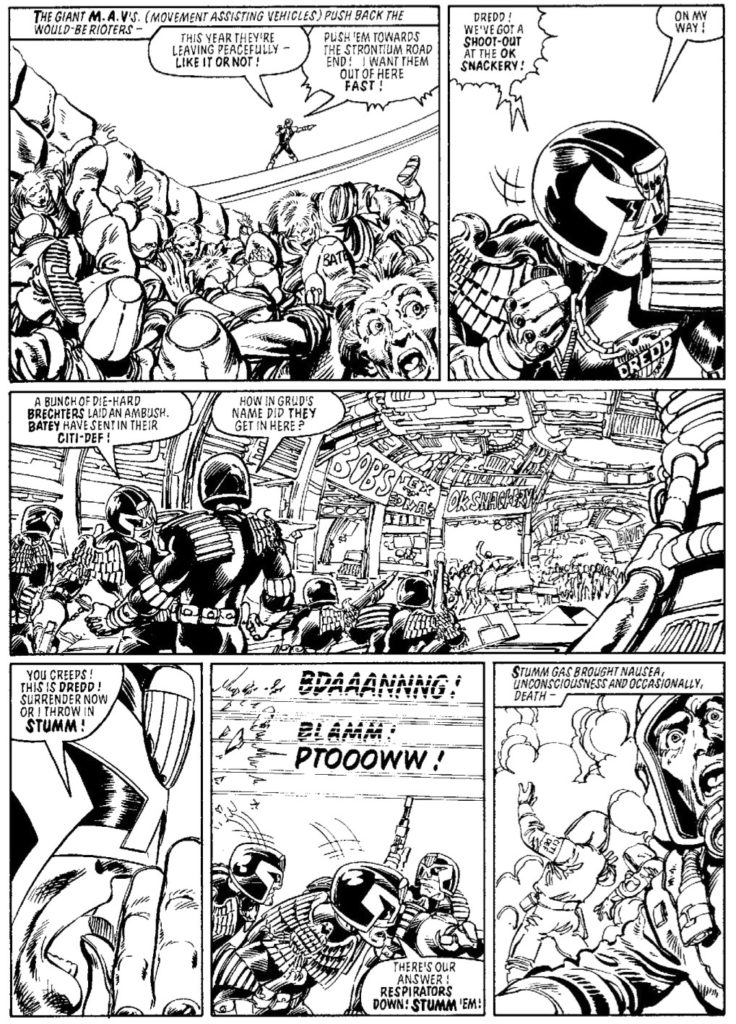
0:49:07:-1:13:05: Can everyone take a moment to enjoy the fact that Jeff and I take quite so long discussing one 14-page story, purely because we cannot get over quite how bad the John Byrne artwork for it actually is? And, oh, friends; it’s very bad artwork indeed, all the worse for being presented next to some truly great stuff from the likes of Brian Bolland, Mike McMahon and Ian Gibson. I mean, just take a look.

This was when he was being considered one of the finest artists in the American comic book industry. Just think about that.
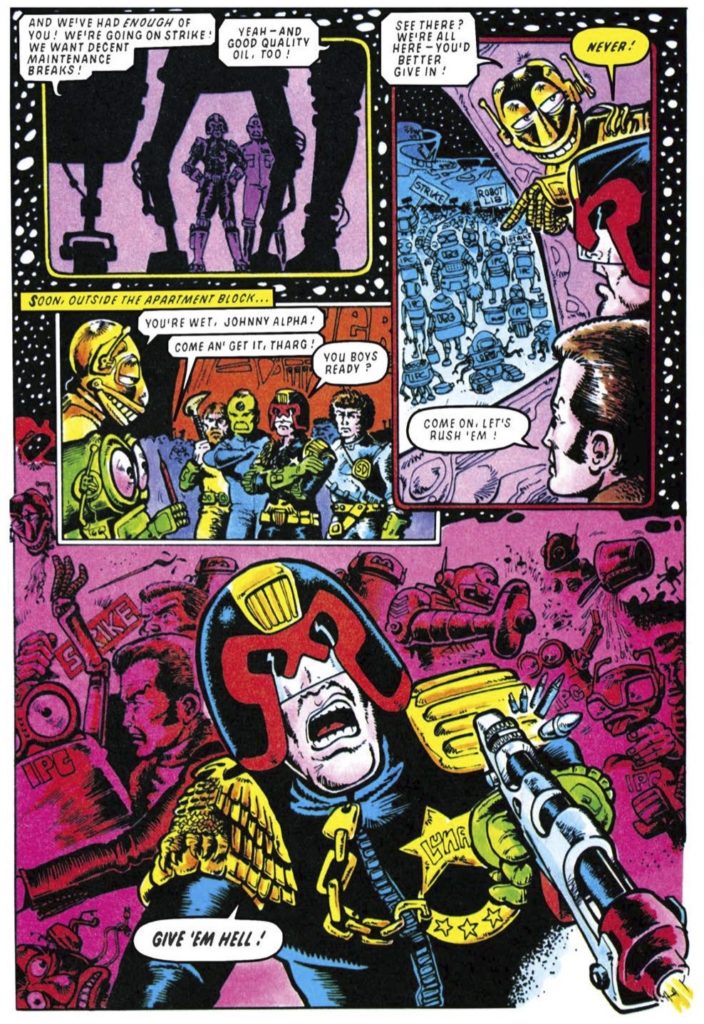
1:13:06-1:23:46: Jeff is clearly trying to wrap things up early, but I won’t let him; instead, we end up talking about how surreal the story from the Dan Dare annual is. It’s so off-model that it reads like a parody that accidentally got published, but it’s also one of the meanest parodies you can imagine, making everyone depicted — and involved — seem a little worse by comparison. Of course, we come up with some conspiracy theories about the story’s creation and just who was actually behind it, because it’s us.
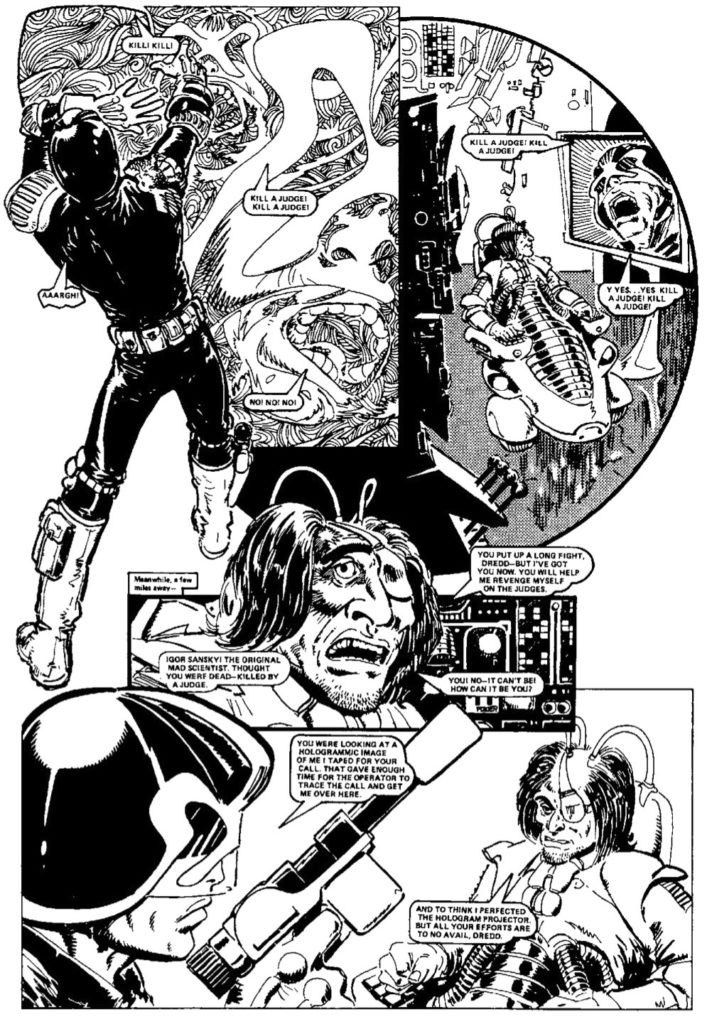
1:23:47-1:34:21: If this is, as we describe it, a book for completists only, then what kind of completist? (An art-lover, if nothing else.) Do we think that because we’ve been spoiled by “better” Dredd in earlier Case Files volumes, or is this genuinely lacking — and if so, is that the case because these stories exist outside the context in which they were originally published? All of that gets brought up, if not necessarily resolved, here!
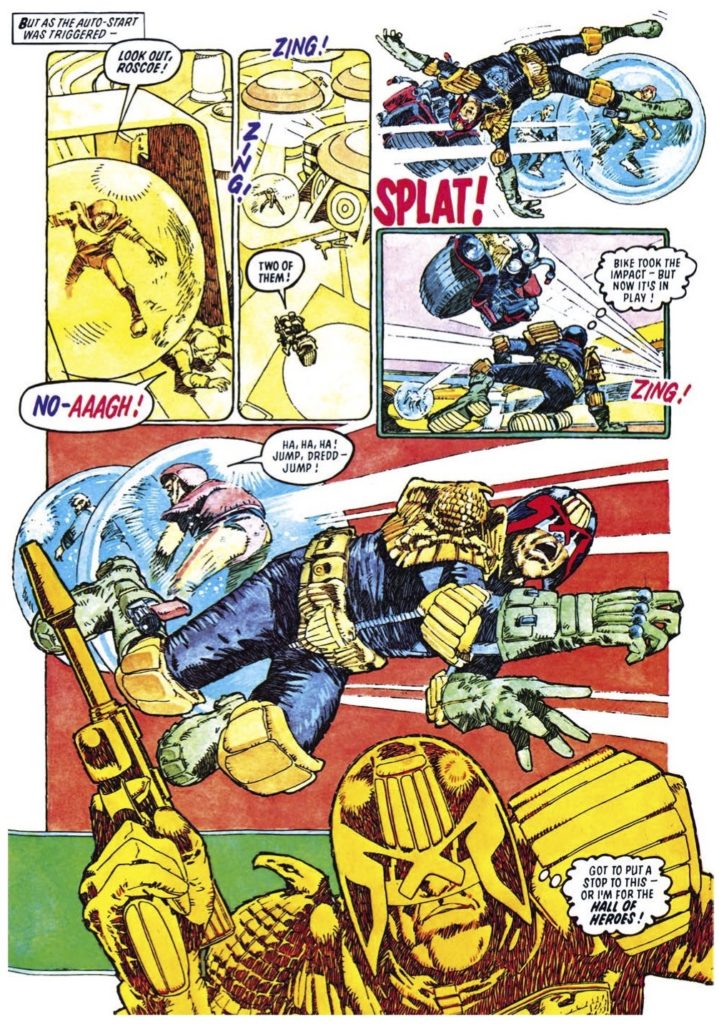
1:34:22-end: We have a long, meandering trail towards the end by talking about the inherent flaws of the annual as a narrative chapter in an ongoing story, talk more about just how disappointing this volume is, and then finally wrap things up by talking about the Twitter, Tumblr, Instagram and Patreon of it all. Next month, we get back to the Case Files proper with the 10th volume, and let me just tell you, Jeff and I are very much looking forward to it, thank you very much. And while I’m thanking you, thank you for reading through all these show notes, as ever.


And for those looking for a direct link to the episode… http://theworkingdraft.com/Media/Drokk/DrokkEp10.mp3
Well, your review makes me happy I didn’t go and look for this book. I do have the Judge Dredd Annual 1981 on my shelf, which I kept for the lovely Mike McMahon art. It’s got Pinboing Wizard, Compulsory Purchase and The Fear That Made Milwaukee Famous, so my Thrill Power to Thrill Sucker ratio is not too bad. There is a puzzle for me, though, and that’s the cover. It’s a well-drawn Bolland Dredd on a LawMaster bursting through a page. Conventionally, you might expect that page to be something like a 2000AD cover, he would be bursting from the pages of that comic into his own annual. It’s not, though. It’s an abstract, complex pattern of black lines on squared paper. I wish I could read it as a map, but no. Anyone have any ideas?
It was interesting to hear you talk about Cam Kennedy perhaps being influenced by Mike McMahon’s approach to colour. I’ve always thought that Kennedy’s art showed a lot of McMahon influence, as if he taken elements of McMahon’s style and refined it into a more classical version than McMahon’s restless iconoclasm. This may be one of those cases where my ignorance of an earlier Ur influence on both artists is deceiving me.
It is odd to see Kevin O’Neill drawing in a different style. I’ve a copy of his small press comic from 1976, Mek Memoirs and his style is very recognisable there, though the influences of Wood and Eisner are more obvious.
Speaking of Eisner, as so often happens in Drokk, is the Walter the Wobot strip homaging the Spirit Elevator story in this volume of the Restricted Files? It’s written by G. P. Rice, which isn’t a name I recognise, so suspect may be another pseudonym.
The Satan story is wonderful, damn it, and Graeme McMillan has lost his sense of fun and is dead inside. I feel vaguely that he is on the verge of being the main character in a heartwarming movie in which a child reopens his eyes to the joy and possibility of life.
But more seriously, I think, for me, part of what works about Mega-City One is that *everything* works there. So yes, you can have supernatural stories, and yes, you can have aliens from outer space, along with the more “realistic” weirdness. As long as Dredd himself regards it all as basically normal, so that you have the sbsurd contrast between “This is #@!$%!# insane and makes no sense” and the ultraviolent bureaucrat following the rules without a trace of (intradiegetic) irony. Because for Dredd, the rules always work in every situation.
Now that isn’t, and shouldn’t be, every Judge Dredd story. But, at least for me, neither should every Judge Dredd story be a serious exploration of life under totalitarianism like Letter from a Democrat. I think this might be why I’m with Jeff Lester that There Someone on Line 9 is the best story in here, while it didn’t make Graeme McMillan’s top 3.
There’s a point of view (e.g. Douglas Wolk) that would say that once you have stories like Letter from a Democrat, the ordinary citizens of Mega-City One can never legitimately go back to being shallow and crazy — because totalitarianism is just too serious as a theme, and if you portray the citizens as wacky and irresponsible (which is definitely what’s going on in TSOL9), that justifies Dredd. That position would tend to imply that previous Dredd stories in that mold (which is a lot of them) were getting it terribly wrong, and that one should look at the early history of the strip entirely in terms of those little moments that show progress towards the model of Letter from a Democrat.
But I think that view doesn’t give readers enough credit, because it’s supposing that we can’t recognize the portrayal of the call-in show in TSOL9 as *caricature*, something that operates according to a different set of rules from a story like LfoD, and that neither invalidates the other.
And, as far as Beat the Devil specifically goes, I think you do have to buy in — this is taking advantage of the annual to write a Christmas story, not in the sense of being literally set at Christmas, but in the sense of being in a special time that suspends the normal rules. (Insert Bakhtin reference here.) It’s not “really” a folktale, or rather a folksong, after all — the joke (not a fabulous joke – I’m not that big a defender of this throwaway bit of annual fun) in the last panel is that it’s all true (“true”) and the Devil really is locked up in an iso-cube.
I think that to comment that it’s ridiculous that Dredd hasn’t sinned is to apply the wrong rules. That’s to take the concept of “sin” seriously, and what about this story suggests that it is doing that? Definitely not the hilarious little image of Dredd with a halo above his helmet.
And — maybe going out on a limb here — there’s a point there, of the kind that’s best made through humor, about an either/or morality of right and wrong in which wrong is best handled by having a perfect hero beat the crap out of it. Isn’t that just silly? But don’t we insist on taking it seriously, over and over again?
A Judge Dredd that doesn’t have room for this sort of thing is a significantly poorer Judge Dredd, I think.
Mind you, I can’t quite get on board with Jeff Lester’s affection for Law of the Jungle. Part of that is that I don’t see that it’s such a good idea to get rid of all the goofy — the fact that Mega-City One can have such wildly incoherent shifts of tone in it is part of what makes it such an effective exploration of the idea of the city, the place with all sorts of difference in it, side by side.
But the problem is that apes have far too frequently been used as code for various oppressed groups, especially Africans, and the whole thing about “they’ve become uncivilized, so there’s no choice but to massacre them’,” done absolutely straight — yeah, that’s a bit too much.
And on the topic of racism, let’s not forget Tarantula. Mutants have functioned before as the Native American stand-ins when Dredd is in Western mode, the outsiders who define what civilization is. But wow, this is uncomfortably literal in a very racist way.
Other thoughts:-
– Steve Dillon was only 18 when he drew his story here.
– I love how in this allegedly locked-down totalitarian society you can just pick up obviously dangerous equipment like “lase-cutters” in the local shop.
-on annuals, it’s worth adding that they were much more expensive than the regular comics. I looked up the price for the 1980 annual, and it cost £1.25 (£5.30 in today’s money) at a time when the comic’s price had recently been put up to 14p.
These really were an utterly different thing from the regular comic, to an extent that means that they just don’t compare with an American “annual.” Physically, a normal issue (at this time) would in comparison with an American comic, appear horribly cheap in terms of paper quality, especially the cover, while an annual went in the opposite direction, a much more lavish production than anything routine in the American comics industry.
This was because they were older than comics as an institution, going back to Victorian children’s annuals. So a British comics annual was a comic doing an annual, while an American comics annual was a special edition of the comic.
As an American, this line stands out:
“– I love how in this allegedly locked-down totalitarian society you can just pick up obviously dangerous equipment like “lase-cutters” in the local shop.”
Absurd, yeah. But I live in a country where you can be thrown in jail for a small amount of drugs and also buy a shotgun at the local sporting goods store.
The amusing thing is I’ve been living in the US for over 20 years, and yet that thought did not occur to me.
As far as I can remember this is only the first time that the devil is beaten up by Dredd (and then again by Anderson).
Dredd is pretty impressive that it is not much surprise to see Dredd fight a time displaced WWI fighter pilot, then arrests and imprisons a man for jay-walking, then turns around and fights the devil himself. All in a day’s work for a judge!
The Graveyard Shift, which is in a much later Case Files, really shows how much goes on in a single night for Dredd, and goes a way to explain why nothing fazes him!
It has been a long time since I read the restricted files, but I remember thinking it was completely throw away, and only a completionist ( read fool like myself) need really seek it out to read.
It is a wasted opportunity though, Dredd can work very well in stand alone stories. He doesn’t require his stories to be 30 pages to be excellent! So one would think that these full colour annuals would be the place to put some of the best Dredd stories. They would look awesome, people who read the progs would know that annuals and specials were unmissable! Instead it is where the junk ended up as they had a rule in 2000ad that if you paid for a story, it had to see print.
I am looking forward to a return to the Case Files proper next time, it is a mixed bag if I remember but introduces the Taxidermist, which is a fun character who ends up with his own excellent story line in the future!
Keep up the good work guys!